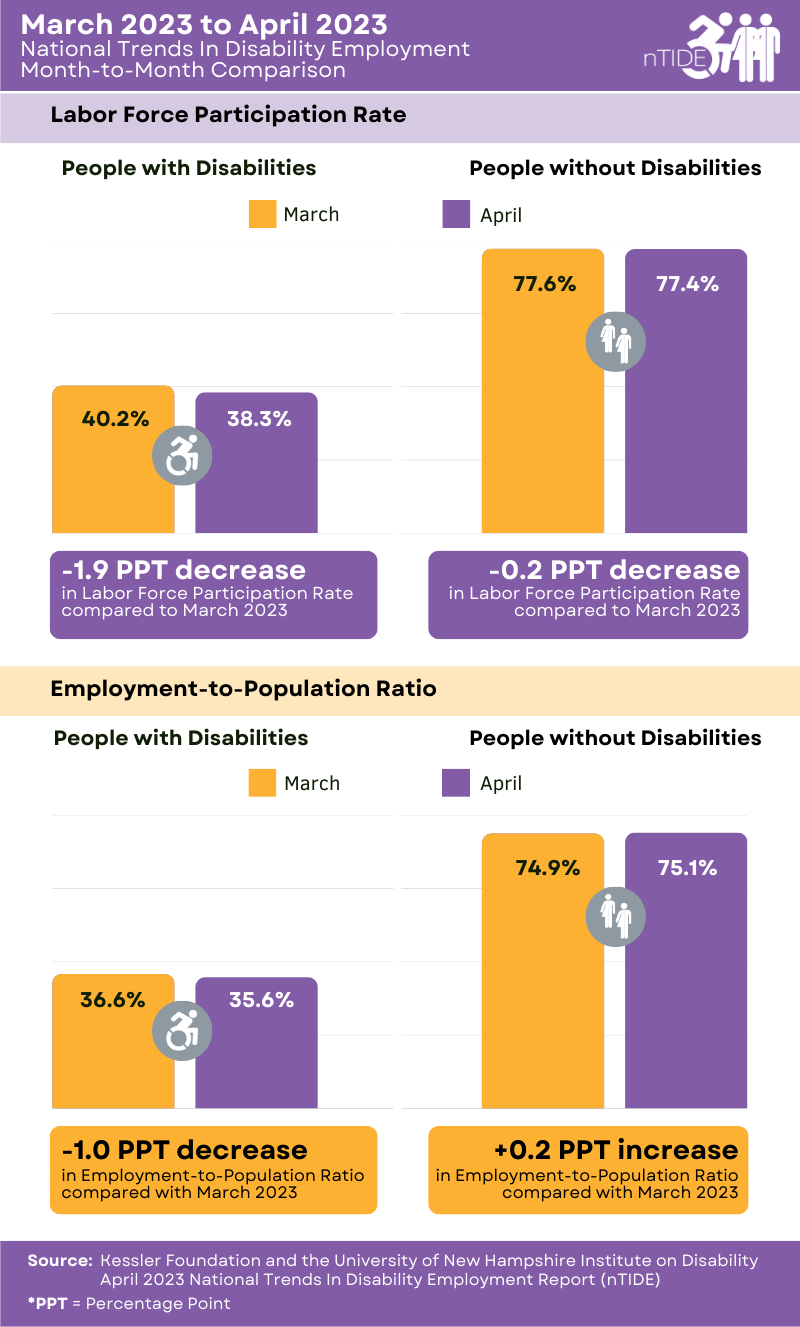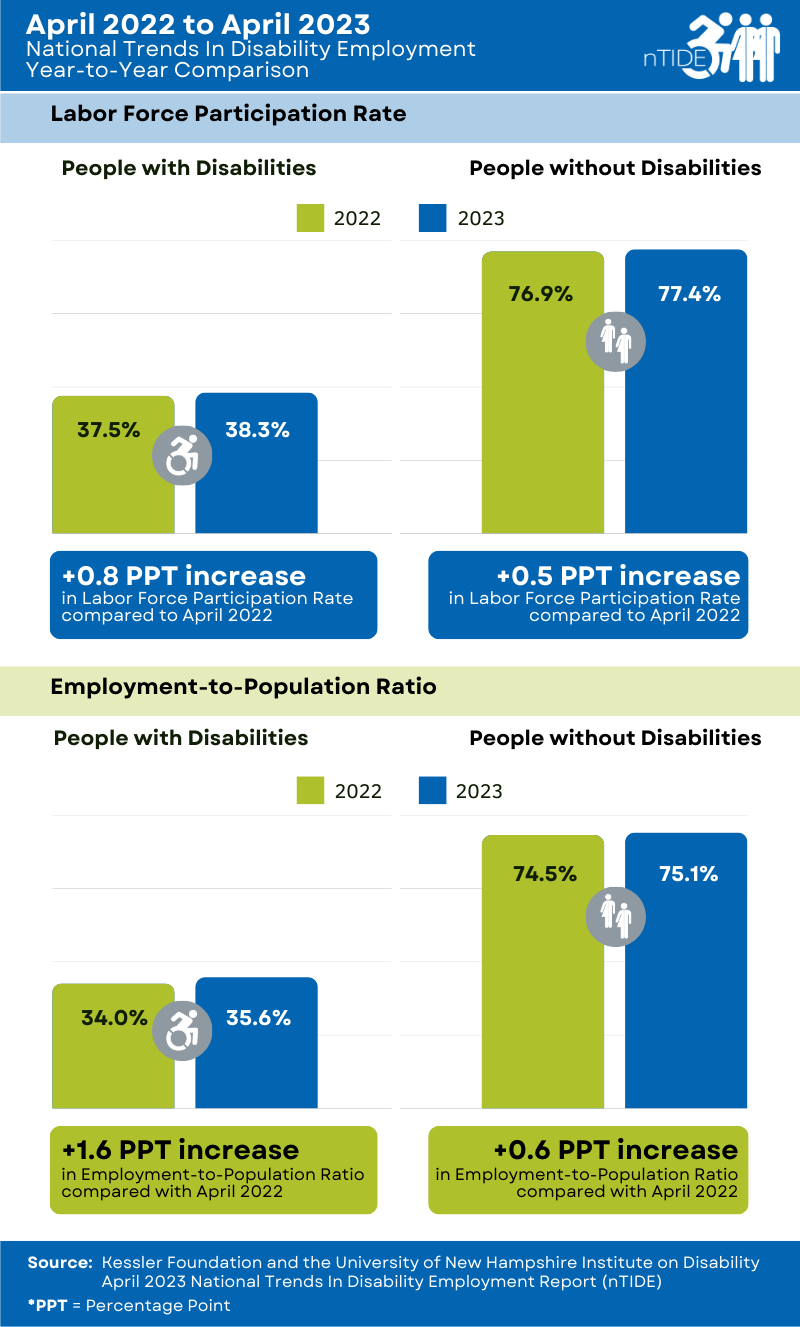National Trends in Disability Employment (nTIDE) – Issued semi-monthly by Kessler Foundation and the University of New Hampshire
East Hanover, NJ – May 5, 2023 –Declines in the April job numbers for people with disabilities raise concerns about the future of the job market, according to today’s National Trends in Disability Employment – semi-monthly update (nTIDE), issued by Kessler Foundation and the University of New Hampshire’s Institute on Disability (UNH-IOD). To assess whether this change signals a slowing of job gains for people with disabilities, nTIDE experts will look closely at the direction of next month’s employment indicators.
Month-to-Month nTIDE Numbers (comparing March 2023 to April 2023)
Based on data from the U.S. Bureau of Labor Statistics (BLS) Jobs Report released today, the employment-to-population ratio for working-age people with disabilities (ages 16-64), the employment-to-population ratio for people with disabilities (ages 16-64) decreased from 36.6 percent in March 2023 to 35.6 percent in April 2023 (down 2.7 percent or 1.0 percentage point). For people without disabilities (ages 16-64), the employment-to-population ratio increased from 74.9 percent in March 2023 to 75.1 percent in April 2023 (up 0.3 percent or 0.2 percentage points). The employment-to-population ratio, a key indicator, reflects the percentage of people who are working relative to the total population (the number of people working divided by the number of people in the total population multiplied by 100).
nTIDE Month-to-Month Comparison of Labor Market Indicators for People with and without Disabilities

force participation rate for people with disabilities and a slight increase for people without disabilities.
The employment-to-population ratio decreased for people with disabilities and increased slightly for people
without disabilities.
“Given April’s fairly large decline in their employment-to-population ratio, the employment gains experienced by people with disabilities over the last two years appear to be coming to a halt. At the same time, people without disabilities had a small increase in their employment-to-population ratio,” remarked Andrew Houtenville, PhD, professor of economics and research director of the UNH-IOD. “This decline for people with disabilities is likely more than just seasonal fluctuation and/or sample variation. We will be looking to next month to see whether the employment of people rebounds or continues to decline,” he added.
With regard to labor force participation, the labor force participation rate for people with disabilities (ages 16-64) decreased from 40.2 percent in March 2023 to 38.3 percent in April 2023 (down 4.7 percent or 1.9 percentage points). For people without disabilities (ages 16-64), the labor force participation rate also decreased from 77.6 percent in March 2023 to 77.4 percent in April 2023 (down 0.3 percent or 0.2 percentage points). The labor force participation rate reflects the percentage of people who are in the labor force (working, on temporary layoff, on furlough, or actively looking for work in the last four weeks) relative to the total population (the number of people in the labor force divided by the number of people in the total population multiplied by 100).
“While the April numbers are disappointing, the employment and labor force participation of people with disabilities still remains above the levels seen pre-COVID and in April 2022,” said John O’Neill, PhD, director of the Center for Employment and Disability Research at Kessler Foundation. “With the Federal Reserve continuing to raise rates to slow the economy, we expect the job market to be impacted at some point in the coming year,” he added.
In April, among workers ages 16-64, the 5,743,000 workers with disabilities represented 3.8 percent of the total 150,217,000 workers in the U.S.
Year-to-Year nTIDE Numbers (comparing April 2022 to April 2023)
Compared to the same month last year, the labor force participation rate for people with disabilities (ages 16-64) increased from 37.5 percent in April 2022 to 38.3 percent in April 2023 (up 2.1 percent or 0.8 percentage points). For people without disabilities (ages 16-64), the labor force participation rate also increased from 76.9 percent in April 2022 to 77.4 percent in April 2023 (up 0.7 percent or 0.5 percentage points).
nTIDE Year-to-Year Comparison of Labor Market Indicators for People with and without Disabilities

with and without disabilities.
Regarding employment, the employment-to-population ratio for working-age people with disabilities (ages 16-64) increased from 34 percent in April 2022 to 35.6 percent in April 2023 (up 4.7 percent or 1.6 percentage points). For working-age people without disabilities, the employment-to-population ratio also increased from 74.5 percent in April 2022 to 75.1 percent in April 2023 (up 0.8 percent or 0.6 percentage points).
Ask Questions about Disability and Employment
Each nTIDE release is followed by an nTIDE Lunch & Learn online webinar. This live broadcast, hosted via Zoom Webinar, offers attendees Q&A on the latest nTIDE findings, provides news and updates from the field, and features invited panelists who discuss current disability-related findings and events.
On May 5, 2023, at 12:00 pm Eastern, Jade Gingerich, director of Employment Policy for the Maryland Department of Disabilities, joins Dr. Houtenville and Denise Rozell from the Association of University Centers on Disabilities (AUCD). Join our free Lunch & Learn live or visit the nTIDE archives at: ResearchonDisability.org/nTIDE.
Register now for our mid-month Deeper Dive into employment trends at nTIDE Deeper Dive - 5/19/2023 | Center for Research on Disability
NOTE: The statistics in the nTIDE are based on BLS numbers but are not identical. They are customized by UNH to combine the statistics for men and women of working age (16- 64). nTIDE is funded by Kessler Foundation and was initially funded by grants from the National Institute on Disability, Independent Living and Rehabilitation Research (NIDILRR) (90RT5037).
About nTIDE Updates
National Trends in Disability Employment (nTIDE) is a joint project of Kessler Foundation and the University of New Hampshire Institute on Disability. The nTIDE team closely monitors the job numbers, issuing semi-monthly reports that track the impact of economic shifts on employment for people with and without disabilities. As the effect of the COVID-19 pandemic continues to wane and inflation persistently rises, the nTIDE team has superseded its mid-month COVID Update to a “Deeper Dive” into the BLS data for people with disabilities.
About the Institute on Disability at the University of New Hampshire
The Institute on Disability at the University of New Hampshire was established in 1987 to provide a university-based focus for the improvement of knowledge, policies, and practices related to the lives of persons with disabilities and their families. For information on the Intitute’s NIDILRR-funded Rehabilitation Research and Training Center on Disability Statistics and Demographics (StatsRRTC), visit ResearchOnDisability.org
About Kessler Foundation
Kessler Foundation, a major nonprofit organization in the field of disability, is a global leader in rehabilitation research. Our scientists seek to improve cognition, mobility, and long-term outcomes, including employment, for adults and children with neurological and developmental disabilities of the brain and spinal cord including traumatic brain injury, spinal cord injury, stroke, multiple sclerosis, and autism. Kessler Foundation also leads the nation in funding innovative programs that expand opportunities for employment for people with disabilities. We help people regain independence to lead full and productive lives.